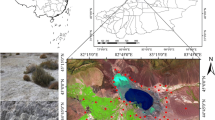Abstract
This paper presents a novel method for estimating black-soil organic matter (SOM) in the black-soil zone of northeast China from hyperspectral reflectance models. Traditional black-soil property measurements are relatively slow, but the pressures of agricultural production and environmental protection require a quick method to collect black-soil organic matter content. SOM estimation using soil hyperspectral reflectance models can meet this requirement, based on the spectral characteristics of black-soil in Northeast China. On the basis of the spectral reflectance and its derivatives, hyperspectral models can be built using correlation analysis and multivariable statistical methods. The concepts of curvature and ratio indices are also applied to compare and test the stability and accuracy of data modeling. The results show that the response of black-soil spectral reflectance from 400–1,100 nm to organic matter content is more marked than that from 1,100–2,500 nm. Specifically, the main response range of black-soil organic matter is between 620–810 nm, with a maximal spectral response at 710 nm. By comparing different models, we found that the normalized first derivate model is optimal for estimating SOM content, with a determination coefficient of 0.93 and root mean squared errors (RMSE) of 0.18%.
Similar content being viewed by others
References
Al-Abbas, A. H., Swain, P. H., & Baumgardner, M. F. (1972). Relating organic matter and clay content to the multispectral radiance of soils. Soil Science, 114(6), 477–485.
Ben-Dor, E., & Banin, A. (1995). Near-infrared analysis as a rapid method to simultaneously evaluate several soil properties. Soil Science Society of America Journal, 59, 364–372.
Chen, N. W., Hong, H. S., Zhang, L. P., & Cao, W. Z. (2007). Risk assessment of nitrogen discharge from a coastal watershed. Pedosphere, 17(4), 467–474.
Cheng, X. F., Shi, X. Z., Yu, D. S., Pan, X. Z., Wang, H. J., & Sun, W. X. (2004). Using GIS spatial distribution to predict soil organic carbon in subtropical China. Pedosphere, 14(4), 425–431.
Cloutis, E. A. (1996). Hyperspectral geological remote sensing: evaluation of analytical techniques. International Journal of Remote Sensing, 17(12), 2215–2242.
Escadafal, R., Girard, M. C., & Courault, D. (1989). Munsell soil color and soil reflectance in the visible spectral bands of Landsat MSS and TM data. Remote Sensing of Environment, 27, 37–46.
Galvao, L. S., & Vitorello, I. (1998). Variability of laboratory measured soil lines of soils from Southeastern Brazil. Remote Sensing of Environment, 63, 166–181.
Goodin, D. G., Douglas, G., Han, L. H., Fraser, R. N., Rundquist, D. C., & Stebbins, W. A. (1993). Analysis of suspended solids in water using remotely sensed high resolution derivative spectra. Photogrammetric Engineering and Remote Sensing, 59(4), 505–510.
Hou, Y. L., Ren, J., & Guo, Z. (2002). Establishment and application of expert system of ecological balanced fertilization: Design of expert system. Chinese Journal of Soil Science (in Chinese), 33(1), 54–56.
Krishnan, P., Alexander, J. D., Butler, B. J., & Hummel, J. W. (1980). Reflectance technique for predicting soil organic matter. Soil Science Society of America Journal, 44, 1282–1285.
Liu, W. D., Baret, F., Gu, X. F., Tong, Q. Z., Zheng, L. F., & Zhang, B. (2002). Relating soil surface moisture to reflectance. Remote Sensing of Environment, 81, 238–246.
Marie-Madeleine, C., Bjorn, B., & Pere, R. (2003). Near infrared reflectance spectroscopy for determination of organic matter fractions including microbial biomass in coniferous forest soils. Soil Biology & Biochemistry, 35, 1587–1600.
Mattikalli, N. M. (1997). Soil color modeling for the visible and near infrared bands of landsat sensors using laboratory spectral measurements. Remote Sensing of Environment, 59, 14–28.
Post, W. M., Izaurralde, R. C., Mann, L. K., & Bills, N. (2001). Monitoring and verifying changes of organic carbon in soil. Climatic Change, 51, 73–99.
Pu, R. L., & Gong, P. (2003). Hyperspectral remote sensing and its applications. Beijing: Higher Education Press (in Chinese) (pp. 52–53).
Stoner, E. R., & Baumgardner, M. F. (1981). Characteristic variations in reflectance of surface soils. Soil Science Society of America Journal, 45, 1161–1165.
Whiting, M. L., Li, L., & Ustin, S. L. (2004). Predicting water content using Gaussian model on soil spectra. Remote Sensing of Environment, 89, 535–552.
Xie, X. L., Sun, B., Zhou, H. Z., & Li, A. B. (2004). Soil organic carbon storage in China. Pedosphere, 14(4), 491–500.
Xu, B. B., & Dai, C. D. (1980). The correlation between Nanjiang soil spectral reflectance property and organic matter. Chinese Science Bulletin, 6, 282–284.
Xu, B. B., Ji, G. S., & Zhu, Y. H. (1991). A preliminary research of geographic regionalization of China land background and spectral reflectance characteristics of soil. Remote Sensing of Environment China (in Chinese), 6(2), 142–151.
Yu, D. S., Shi, X. Z., Wang, H. J., Sun, W. X., Warner, E. D., & Liu, Q. H. (2007). National scale analysis of soil organic carbon storage in China based on Chinese soil taxonomy. Pedosphere, 17(1), 11–18.
Zhang, X. Y. (2005). Spatial variation of soil nutrients in Blacksoil area. Ph.D. dissertation, Institute of Applied Ecology, Chinese Academy of Sciences (in Chinese) (pp. 164)
Zhang, S. H., Ma, C. L., Wu, C. C., & Yu, C. L. (2003). Application of GIS to variable rate fertilization in precision agriculture. Transactions of the Chinese Society of Agricultural Machinery (in Chinese), 34(3), 92–95.
Zhang, W., Yu, Y. Q., Sun, W. J., & Huang, Y. (2007). Simulation of Soil Organic Carbon Dynamics in Chinese Rice Paddies from 1980 to 2000. Pedosphere, 17(1), 1–10.
Author information
Authors and Affiliations
Corresponding author
Rights and permissions
About this article
Cite this article
Liu, H., Zhang, Y. & Zhang, B. Novel hyperspectral reflectance models for estimating black-soil organic matter in Northeast China. Environ Monit Assess 154, 147–154 (2009). https://doi.org/10.1007/s10661-008-0385-4
Received:
Accepted:
Published:
Issue Date:
DOI: https://doi.org/10.1007/s10661-008-0385-4




